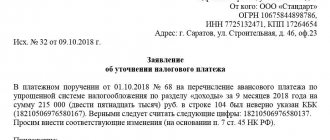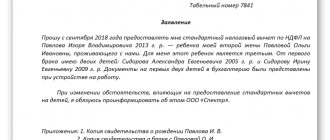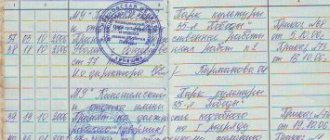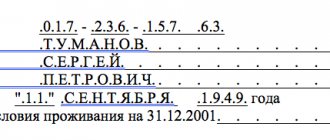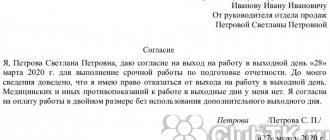Quite often, an accountant “on the side” plays the role of a personnel officer. And this is not surprising, because personnel work is most closely related to the work of accounting. And although personnel documentation, in comparison with accounting documentation, is an example of simplicity and clarity, nevertheless, personnel work sometimes presents the accountant with complex tasks.
In this article, we decided to limit ourselves to only the minimum necessary explanations for a particular situation that may raise questions for an accountant performing the functions of a personnel officer. The main place in the article will be devoted to specific tools for solving the problem. After all, you see, finding an explanation of how to act in a given situation is usually not difficult. It is much more difficult to find specifics - what exactly needs to be done, what documents and how to complete them, etc.
Situation one: change of surname
Let's start with probably the most common situation, which, nevertheless, raises constant questions. We are talking about an employee (usually an employee) changing their last name. Obviously, in this case, it will be necessary to make changes to the personnel documentation, for example, to the employment contract, work book and personal employee card. However, making such changes requires a basis. Such a basis will be documents confirming the change of name, submitted by the employee himself. But you should ensure that the employee submits these documents in advance, and include in the employment contract a standard condition that the employee is obliged to inform the employer about a change of name, passport, place of residence and other personal data specified in the employment contract.
In principle, to begin the procedure for making changes to personnel records, it is enough to simply receive from the employee documents confirming the change of surname - a new passport, marriage certificate. These documents must be copied and certified with the stamp (seal) of the organization and the signature of the accountant. However, we recommend that you still ask the employee to sign the following statement:
Receiving such an application will allow for better organization of document flow, since the documents on the change of surname will be “tied” to this application. This means that in a few years, anyone who opens a personal file (including an inspector) will understand why these particular documents are in the file, and, what is important, at what point the organization became aware of the change in the employee’s last name. In addition, if necessary, visas and other marks can be placed on this application if the document flow system adopted by the organization requires this.
Don’t forget to also immediately give the employee an application for signature in form ADV-2 (approved by Resolution of the Board of the Pension Fund of the Russian Federation dated July 31, 2006 No. 192p). This application is needed in order to begin the procedure for replacing the state pension insurance certificate. You will still have to do this, so it is better to complete all applications at once and not distract the employee any further.
After receiving the application, you can prepare an order to make changes to personnel and other accounting documentation. So, in addition to the already mentioned employment contract, work book and personal card, you will need to make changes to the personal account, the Time Sheet, the Vacation Schedule, the insurance premium card, and the personal income tax card. If a power of attorney was issued for the employee, then it will also have to be redone. In addition, if wages are transferred to a bank card issued by the employer, then you will have to initiate the procedure for replacing the card, and if the company provides the employee with voluntary health insurance, then the procedure for replacing the policy. Accordingly, all these points need to be reflected in the order, which will look something like this:
Yaroslava Zarueva, professional consultant in the field of personnel management, labor relations and labor law, organizational development. Creator of the online course “Effective HR”. Leader of the professional group “HRanitele” Website: www.zarueva.ru
The employee informed the employer about the change in his personal data. What should an employer do?
In the process of interaction with an employee, the employer processes the data that the employee provides to him to formalize labor relations and carry out various operations to administer labor relations and his work activities. Data provided to the employer by the employee himself in accordance with Art. 3 of the Federal Law “On Personal Data” dated July 27, 2006 No. 152-FZ are “personal data”:
Personal data - any information relating to an individual identified or determined on the basis of such information (subject of personal data), including his last name, first name, patronymic, year, month, date and place of birth, address, family, social, property status , education, profession, income, other information.
All documentation within the framework of personnel records management and many accounting documents for settlements with personnel contain personal data of employees. And this information must be relevant, i.e. personal data of employees must correspond to all data in the original documents available to the employee.
https://youtu.be/Jm5oJ98Yi4Y
Requirements for placing an order
The execution of an order, as well as its content, can be completely arbitrary: the document can be printed on a computer or written by hand on company letterhead or on a regular sheet of any convenient format.
Remember! The order must be certified by the “living” signature of the director of the organization or a person authorized to act on his behalf. Also, the order must be signed by the employees responsible for its execution and those whom it directly concerns (in all cases, the use of facsimile autographs is unacceptable).
The need to put a stamp on a document arises only when this norm is enshrined in the internal regulations of the company.
The order to amend the order is drawn up in one original copy, but if necessary, certified copies can be made.
For the entire period of validity, it should be kept in a special folder along with other administrative documentation of the enterprise, and after losing its relevance it should be sent to the archive of the organization, where it should be stored for the period established by the legislation of the Russian Federation or the local legal papers of the organization.
What employer documents contain personal data of employees?
The employee’s personal data is contained in the following documents of the employer: - work book; — employee’s personal card (T2); — employment contract; — employee’s personal account; — other personnel and accounting documents containing the employee’s personal data.
What should an employer do?
In accordance with clause 1 of the “Instructions for the use and completion of forms of primary accounting documentation for the accounting of labor and its payment”, approved by Resolution of the State Statistics Committee of Russia dated 01/05/2004 N 1, when information about an employee changes, new data is entered into his personal card, which is certified signed by a HR employee.
In accordance with clause 9 of the “Rules for maintaining and storing work books, producing work book forms and providing them to employers”, approved by Decree of the Government of the Russian Federation of April 16, 2003 N 225 “On work books” (hereinafter referred to as the Rules), in the work book when it registration, the following information about the employee is entered:
a) last name, first name, patronymic, date of birth (day, month, year) - on the basis of a passport or other identity document;
b) education, profession, specialty - on the basis of documents on education, qualifications or the presence of special knowledge (when applying for a job that requires special knowledge or special training).
According to clause 26 of the Rules, changes to these records are made by the employer at the last place of work.
The law does not oblige the employer to make changes to the employment contract if the employee’s personal data changes. However, according to some experts, it is recommended that such changes be reflected in an additional agreement to the employment contract.
Is it necessary to notify the Federal Tax Service about the change of passport of the general director?
Information about the head of a business company is reflected in the state register (Unified State Register of Legal Entities). Changes in personal data must be recorded in the federal database. The tax authority makes changes if the passport is changed or the general director moves. However, the process does not always require filing an application. Since 2011, the procedure has been automated.
If the director is a foreigner...
Law 129-FZ mentions automatic updating of the register in relation to managers with Russian citizenship. How to change the passport data of a foreign top manager of an LLC is not explained in the regulations. In fact, information about the identity cards of such persons is received by the migration control authorities. Information is collected when a foreigner enters the country (visas, registration at the place of arrival, etc.). However, the mechanisms for transmitting data to tax services are not fixed by regulations.
What is the procedure for making changes to personnel documents?
In a situation where the personal data of an employee changes, it is NECESSARY to issue an order to amend the documents containing personal data. All changes are made only on the basis of an order.
The first step in making changes is an application from the employee with a request to make changes to the documents containing the personal data of this employee. Submitting an application is not a mandatory but advisable step. Directly with a personal statement, the employee must present to the employer original documents that confirm the changed personal data of the employee.
The second step is the issuance of an order. The name of the order may read as follows: “Order to amend documents containing the employee’s personal data.” Of course, other wording is acceptable, but it must be remembered that this order will be the basis for making changes to the employee’s documents containing personal data, so it is worth reflecting this goal directly in the name of the order.
Wording in the order. A common mistake that an employer makes is a formulation like “From such and such a date, count A.I. Ivanova. Filippova A.I. in connection with the registration of marriage..."
This is illiterate from a legal point of view. Filippova Ivanova is considered on the basis of the registration certificate of her marriage, for example, and not on the basis of an order from the employer.
Another common mistake in the wording of the order is the wording: “From such and such a date, make changes to the employee’s personal data...”.
Changing the personal data of an individual, who is your employee, is enshrined as the authority of special government bodies, but not the employer’s personnel service. The personnel service only makes changes to documents containing personal data, based on documents on changes in the personal data of an individual issued by special government bodies to your employee.
Regarding the need to conclude an additional agreement to an employee’s employment contract in connection with a change in the employee’s personal data, there are two opinions expressed by experts.
First: There is no need to conclude an additional agreement with the employee to the employment contract in connection with a change in the last name and other personal data.
This conclusion can be drawn from Article 57 of the Labor Code of the Russian Federation. According to this article, the content of the employment contract includes information and conditions.
Last name, first name, patronymic of the employee, information about the employee’s identity documents are included in the information. According to Part 3 of Art. 57 of the Labor Code of the Russian Federation “the missing information is entered directly into the text of the employment contract, and the missing conditions are determined by an appendix to the employment contract or by a separate agreement of the parties...”.
Correction of the employment contract
——————————T———————————————¬¦ Last name changed to last name¦ Work book ¦¦ “Melnichuk” based on ¦ TK-II N 8561320 ¦¦ marriage certificate, series II-IK N 535283 ¦ -Prozorova-Melnichuk ¦¦ dated July 23, 2005, ¦ Last name ———————————- ¦¦ issued by the Izmailovsky Civil Registry Office¦ Maria ¦¦ Moscow ¦ Name ————————————— ¦¦ Head ¦ Alexandrovna ¦¦ HR Department ¦ Patronymic ——————————— ¦¦ Komarova E.T.
Komarova¦ 04/17/1980 ¦¦ Seal ¦ Date of birth —————————- ¦¦ ¦ (day, month, year) ¦¦ ¦ higher professional ¦¦ ¦ Education —————————— ¦¦ ¦ jurisprudence ¦¦ ¦ Profession, specialty —————— ¦¦ ¦ April 04, 05 ¦¦ ¦ Date of completion “—” —— 20— ¦¦ ¦ Prozorova ¦¦ ¦ Signature of the owner of the book —————— ¦¦ ¦ ¦¦ ¦ M.P. Signature of the person responsible ¦¦ ¦ for maintaining work books ¦¦ ¦ Komarov ¦¦ ¦ —————————- ¦¦ ¦ (legible) ¦L—————————- ———— ——————————— Of course, the personal information about the employee contained in the employment agreement must be changed to current data. However, it is important to remember that the current federal legislation does not define clear rules for the implementation of the relevant event. Typically, several amendment options are used.
In the first case, an addendum to the main document is created, which specifies the date of amendment to the contract. Within this framework, the places in the text where changes need to be made are listed.
Article 72 of the current Labor Code of the Russian Federation in this case does not at all establish requirements for concluding an agreement due to the fact that in fact the terms of the agreement remain the same.
An obsolete surname is crossed out with one line so that it can still be read. The updated information is then written in the blank space.
It is worth noting that in the situation under consideration, affixing an organizational seal is not required.
It is recommended, among other things, to correct the section with the details of the parties - it is also required to include updated data on the passport information of a particular employee. Failure to comply with these requirements leads to the fact that the employment contract may lose its legal force.
Tatyana Skorobogatova, Moscow
PC. filed a lawsuit against the municipal unitary enterprise of consumer services "E***" (hereinafter - MUP "E***") with a claim for reinstatement at work and recovery of average earnings for the period of forced absence, citing the fact that since 21.02 .2007 was hired by the defendant as a hairdresser at the men's salon for a certain period of time, namely during maternity leave, but without specifying the duration of the contract.
On November 12, 2008, by Order No. 135, she was dismissed on the basis of clause 2, part 1, art. 77 of the Labor Code of the Russian Federation (at the end of the employment contract).
On November 10, 2008, she was given notice of her dismissal. In violation of Part 1 of Art. 79 of the Labor Code of the Russian Federation, this notification was provided to her less than three days before her expected dismissal.
In addition, when hiring, an order was issued to hire E.T., and by order dated November 12, 2008 N 135, Sh.T. was fired. No additional agreements were concluded between her and MUP “E***” in connection with the change of name.
We invite you to familiarize yourself with: Agreement for the development of project documentation, sample
She asks to recognize Order No. 135 dated November 12, 2008 on her dismissal as illegal, to reinstate her as a hairdresser at the men's salon of the municipal unitary enterprise "E***" and to recover wages for the period of forced absence from November 12, 2008 until the day the court made the decision.
At the court hearing, plaintiff Sh.T. supported the claims, explained to the court that on February 22, 2007 she was hired by the defendant under an employment contract under the surname “E.” during P’s maternity leave. In 2008, in connection with her marriage, she changed her last name to “Sh.” An employment contract under a new surname was not concluded with her.
She was fired on November 12, 2008 due to the expiration of her employment contract, although she thought that she would continue to work under an indefinite employment contract. There were vacancies, but she was denied a permanent employment contract. She believes that she should have been warned about the upcoming dismissal in advance - a month or two months before the dismissal.
Representative of the plaintiff Z.A. supported the claims, explained to the court that he supported what was stated by the plaintiff. Employment contract with E.T. was concluded for an indefinite period, because no end date was specified. According to Art. 57 of the Labor Code of the Russian Federation, a fixed-term employment contract must indicate its validity period and the circumstances that served as the basis for its conclusion. The plaintiff should have been notified of the termination of the contract three days in advance, which was not done, that is, the dismissal procedure was not followed.
Representative of the defendant N.R. - the head of the enterprise did not admit the claims, she explained to the court that the plaintiff was hired as a hairdresser at the men's salon during the maternity leave of another employee - P. The plaintiff was warned that a fixed-term employment contract was being concluded with her.
The validity period of the employment contract, namely its expiration date, is not specified in this case, because the employer does not know when the absent employee will return to work. In this case, the employee can go to work at any time. According to Art. 79 of the Labor Code of the Russian Federation, she should not have warned the plaintiff about dismissal three days in advance.
Changing the employee's surname does not require the conclusion of an additional employment agreement, because the essential terms of the employment contract do not change. After the plaintiff brought the marriage certificate, an order was issued at the enterprise, changes were made to the work book and other documents, including the copy of the employment contract that is stored in the organization. The plaintiff did not bring her copy of the employment contract to make changes. None of the plaintiff’s working conditions changed after the change of name.
The court made the said decision.
In the cassation appeal of Sh.T. asks the court's decision to be quashed and the case sent for a new trial, because believes that the court did not evaluate her arguments that a fixed-term employment contract should be concluded with her in accordance with Art. 59 of the Labor Code of the Russian Federation, and upon its termination, a notice must be sent to her at least three days in advance, as determined by Part 1 of Art. 79 of the Labor Code of the Russian Federation, but no notice was sent to her and thus the dismissal procedure was violated.
The validity period of the employment contract has not been determined, which means it is concluded for an indefinite period, and therefore notification is required. The employee, in whose place the plaintiff was invited, was initially granted maternity leave for up to one and a half years, and then, according to the latter’s application, maternity leave for up to 3 years, and thus the validity period of the employment contract was not determined.
According to Letter of the Federal Employment Service dated December 28, 2006 N 2264-6-1, the employer has the right to hire another employee to replace an employee on maternity leave (child care leave). In this case, a fixed-term employment contract is concluded with the employee, which must indicate the duration of its validity and the circumstances (reasons) that served as the basis for concluding a fixed-term employment contract.
Due to the fact that it is not always possible to determine the exact time of the main employee’s return to work, the expiration date of the employment contract will be the departure of the main employee. After the main employee returns to work, the fixed-term employment contract with the “temporary” employee is terminated due to the expiration of its term (Clause 2, Part 1, Article 77).
In his objections to the cassation appeal, the head of the municipal unitary enterprise “E***” points to the legality of the court decision, because the court reasonably concluded that the dismissal procedure was not violated, since by virtue of Part 2 of Art. 79 of the Labor Code of the Russian Federation, upon expiration of the employment contract concluded for the duration of the duties of an absent employee, warning the employee in writing at least three calendar days before dismissal is not required. The plaintiff’s assertion that an employment contract was concluded with her for an indefinite period does not correspond to the circumstances of the case.
In the cassation instance, plaintiff Sh.T. and her representative Z.A. the arguments set out in the cassation appeal were supported.
Representative of the defendant N.R. asked to refuse the cassation appeal, since the dismissal of the plaintiff was carried out in accordance with the law.
Prosecutor of the Prosecutor's Office of the Jewish Autonomous Region V.K. explained that the court's decision complies with the requirements of the law and there are no grounds for its cancellation.
Having checked the case materials, listened to the persons participating in the cassation instance, discussed the arguments of the cassation appeal and objections to it, the judicial panel does not find any grounds for canceling the court decision.
In accordance with Art. 58 of the Labor Code of the Russian Federation, employment contracts can be concluded for a certain period of no more than five years (fixed-term employment contract), unless a different period is established by this Code and other federal laws.
A fixed-term employment contract is concluded when the employment relationship cannot be established for an indefinite period, taking into account the nature of the work to be done or the conditions for its implementation, namely in the cases provided for in Part 1 of Art. 59 of the Labor Code of the Russian Federation. In cases provided for in Part 2 of Art. 59 of the Labor Code of the Russian Federation, a fixed-term employment contract can be concluded by agreement of the parties to the employment contract without taking into account the nature of the work to be performed and the conditions for its implementation.
According to Art. 59 of the Labor Code of the Russian Federation, a fixed-term employment contract is concluded for the duration of the duties of an absent employee, who, in accordance with labor legislation and other regulatory legal acts containing labor law norms, a collective agreement, agreements, local regulations, and an employment contract, retains his place of work.
As can be seen from the case materials, the hairdresser of the men's salon P.A. was hired at the Municipal Unitary Enterprise "E***" for an indefinite period from June 25, 2003.
We invite you to familiarize yourself with: Sample power of attorney for transfer of funds
07/11/2006 P.A. gave birth to a child - P.P., which is confirmed by birth certificate I-TV N 523169. By Order of September 14, 2006 N 96, she was granted maternity leave for up to one and a half years, and by Order of January 11, 2008 N 3 - parental leave for a child under three years old.
According to Art. 256 of the Labor Code of the Russian Federation, during the period of parental leave, the employee retains his place of work (position).
Plaintiff Sh.T. from 02/22/2007 to 11/12/2008 she worked at the municipal unitary enterprise "E***" as a hairdresser in the men's salon (employment application dated 02/21/2007, employment order dated 02/21/2007 N 13, employment agreement (contract) dated 02/21/2007 N 2.
From these documents it follows that a fixed-term employment contract was concluded with the plaintiff for the duration of P.A.’s maternity leave.
By order of November 12, 2008 N 135 Sh.T. as of November 12, 2008, she was dismissed from her job under clause 2, part 1, art. 77 of the Labor Code of the Russian Federation (due to the expiration of the employment contract).
In accordance with clause 2, part 1, art. 77 of the Labor Code of the Russian Federation, one of the grounds for termination of an employment contract is the expiration of the employment contract (Article 79 of the Labor Code of the Russian Federation).
According to Art. 79 of the Labor Code of the Russian Federation, a fixed-term employment contract is terminated upon expiration of its validity period. The employee must be notified in writing of the termination of the employment contract due to its expiration at least three calendar days before dismissal, with the exception of cases where a fixed-term employment contract concluded for the duration of the duties of the absent employee expires.
Taking into account the basis for concluding a fixed-term employment contract with the plaintiff, the right of a temporarily absent employee to go to work at any time, a specific date for the end of the employment contract could not be determined, which, however, does not make the employment contract valid for an indefinite period.
The obligation to provide a temporarily absent employee who retains a job, if he intends to return to work, immediately does not allow the employer to notify the temporary employee of the upcoming dismissal three days in advance, and the law exempts him from such an obligation in this case.
In this regard, the plaintiff’s arguments about violation of the procedure for her dismissal are refuted by the evidence presented by the employer and are not based on the law. Taking into account the above, the panel of judges considers the court’s conclusion correct that the dismissal of plaintiff Sh.T. is legal, and sees no grounds for canceling the court’s decision based on the arguments set out in the cassation appeal.
Changing information about an employee in the work book.
Clause 2.3 of the Instructions establishes the following rules for making changes to information about an employee in the work book:
- changes in entries in work books about surname, name, patronymic and date of birth are made on the basis of a passport, birth certificate, marriage certificate, divorce certificate, change of surname, name, patronymic and other documents and with reference to their number and date;
— these changes are made on the first page (title page) of the work book;
- the previous surname or first name, patronymic, date of birth are crossed out with one line and new data is recorded;
- references to the relevant documents are made on the inside cover of the work book and certified by the signature of the employer or a person specially authorized by him and the seal of the organization (or the seal of the personnel service).
Some experts believe that records of changes in surnames should be made not only on the basis of a certificate, but also simultaneously on the basis of a passport.
In practice, the new surname is written next to the crossed out one, under the crossed out one, above the crossed out one, depending on the availability of free space.
Who can be trusted to draw up such an order?
The formation of an order to amend the order can be entrusted to any employee of the enterprise who has the necessary powers and has an idea of how to write administrative documents. Most often, this is a person close to the management of the company: a legal adviser, a specialist in the personnel department, a secretary.
However, regardless of who directly draws up the document, he must submit the finished order to the director of the organization for signature - without his autograph, the order will not acquire legal status and can easily be challenged with the help of a labor inspectorate or court.
It should be said that the more carefully and attentively the employee involved in the formation of the order treats his job functions, the less likely it will be for the company’s management to find themselves under the close attention of regulatory authorities.
Changing information about the employee in the employee’s personal card (T2).
There are several options for making such changes to your personal T2 card.
For example, an employee got married and changed her last name. The previous surname can be crossed out with one line, and the new surname can be indicated on the right side on the paper medium of the T2 personal card.
By the way, this is why in a line intended to indicate a surname, it is usually recommended to write it closer to the left edge. Then there is room to indicate the new surname to the right. You should also indicate on the basis of which document the changes were made.
This can be done in the field of the personal card opposite the line where the previous surname is crossed out and the new one is written - “Marriage Registration Certificate II-MT No. 115116 dated 08/10/2005.” The responsible employee certifies this entry here with his signature and puts down the date of the changes. If there is no space on the right, then the new surname can be written at the top.
Information about the document confirming the change of surname and the certification signature of the personnel employee can also be indicated in section X of the personal card “Additional information”.
Another option used in this case in personnel practice is to print a page of a T2 personal card from the employer’s electronic data system with changes made or additional lines under the column for making changes.
In this case, a note is made on the old page indicating that the page was replaced due to a change in the surname. The new page also reflects the fact that the pages have been replaced.
If an additional agreement is concluded to the employee’s current employment contract on changing personal data, the additional agreement is drawn up in exactly the same way as other additional agreements to the employment contracts of the parties to the employment contract.
Similar recommendations for making changes to employee documents prepared by the employer can be given regarding changes in other information about the employee.
How to make changes: procedure
Some employees of organizations neglect to make changes to existing orders, believing that they can do without them. However, this point of view is incorrect, since an order is a document that regulates legal relations in an organization in strict accordance with the law, and therefore has serious legal significance.
The order is mandatory, and if any of its clauses sounds incorrect or erroneous, in the event of disputes and disagreements, it will not be easy to prove the employer is right, which means that both the enterprise as a whole and its management can be brought to administrative liability.
Changes to the order must be carried out according to a certain algorithm:
- A decision is made that these changes are really necessary and inevitable.
- A special order is issued, which fixes the need to make amendments to an existing document and includes a list of positions that are subject to adjustments.
- The order is signed by the head of the enterprise and responsible employees, and from the date indicated in it, the changes take effect.
The legislation of the Russian Federation does not in any way limit the frequency of amendments to this document.
Therefore, you can do them at least every week.
But if the order so badly requires editing or its points and provisions at some point become completely irrelevant, then it is much easier to cancel it and, if necessary, create a new one.
Requisites
Despite the fact that the order does not have a form established by law, it is recommended that it be drawn up in accordance with the general requirements for administrative documents:
- The header of the document contains the name of the organization, place of compilation, number, date and title of the document.
- The preamble states the rationale for issuing the document (the circumstances that led to its creation) and the basis (reference to a specific document or legislative act).
- The main part of the order contains:
- the manager’s order to approve the order;
- list of documents subject to change;
- an indication of the person or persons (position, full name) responsible for making changes to documents containing personal information about the employee.
Which orders and in which part of them can changes occur?
Almost any orders can be edited, with inaccuracies and violations, wittingly or unwittingly. These could be orders:
- relating to the working conditions of employees;
- some local documents (staffing schedule, vacation schedule, etc.);
- changes of officials;
- relations between employer and subordinates.
As for those parts of the order that can be subject to adjustments, they can also be anything: the basis, main part, conclusion can be edited.
Example
| Content | Example |
| "Head" of the order | _____(company name, place of preparation) Order for inclusion in accounting documents No. ___from ______. |
| Preamble | In connection with the change of surname from ___ (former employee data) to ___ (new employee data), I order: Make the necessary changes to the documents containing personal data ____________ (former employee data, position). |
| Base |
|
| Main part | By______(date): |
- Prepare an additional agreement to the employment contract with ____ (former last name), taking into account the change in personal data.
- Enter information about the change of surname into the work book________.
- Enter information about the change of the employee’s surname and passport details into the personal card________.
- Make changes to the Timesheet, vacation schedule and personal account.
- Ensure that new PD _____ is taken into account when preparing tax reporting and reporting to extra-budgetary funds.
I appoint ________ (position, full name) as responsible for the execution of the order.
- order to change the employee’s personal data
- order to change the employee’s passport data
Based on the order, the following actions are performed:
The necessary changes are made to the employee’s personal card in Form No. T-2.
- new data is entered into the work book and into the book for recording the movement of work books (according to clause 26 of Chapter 3 of the Decree of the Government of the Russian Federation of April 16, 2003 No. 225 “On work books”, as well as clauses 2.3 and 2.4 of Chapter 2 of the Instructions for filling out work records books).
- Changes to the employment contract are made by analogy with the work book (drawing up an additional agreement is optional).
- Changes are reflected in the employee’s personal account data (for the correct calculation of wages).
- When changing your last name, an application for exchange of the insurance certificate is submitted to the territorial body of the Pension Fund within a month (using forms No. ADV-2 and No. ADV-6).
From July 1, 2020, when providing incomplete, outdated or inaccurate data, a new type of administrative violation was introduced. The following are subject to a warning or fine:
- Citizens - from 1000 to 2000 rubles.
- Officials (for example, directors, personnel officers or chief accountants) - from 4,000 to 10,000 rubles.
- Individual Entrepreneurs (IP) – from 10,000 to 20,000 rubles.
- Legal entities – 25,000 to 45,000 rubles.
Compliance with the law on personal data and timely provision of information about their changes is the responsibility of both the employer and the employee.
Didn't find the answer to your question? Find out how to solve exactly your problem - call right now:
+7 (Moscow) +7 (St. Petersburg)
Form 1P - forms and samples of completion
An application for the issuance (replacement) of a passport of a citizen of the Russian Federation (Form No. 1P) is filled out by the citizen applying for a passport, by hand or using technical means (typewriters, computers), without unofficial abbreviations, abbreviations, corrections and erasures. Handwritten text must be neat and legible using only black ink or ink.
The specified application is printed on punched card paper, its size is 210 X 148 mm, which is half an A4 sheet. The application form for the issuance (replacement) of a passport of a citizen of the Russian Federation (Form No. 1P) is provided in accordance with the new Administrative Regulations of the Ministry of Internal Affairs of Russia. Front side: Back side: Let's consider the established rules for filling out some points of the application form for the issuance (replacement) of a passport of a Russian citizen (Form No. 1P), which cause the greatest difficulties in practice: Point 5.
- "Family status". Indicated:
- “married”, and also additionally - last name, first name, patronymic, date of birth of the spouse (wife) - personal data that the spouse (wife) had before marriage, as well as the name of the body that carried out the state registration of the marriage, and date of marriage – if the applicant is currently married;
- “I am not married” - if the applicant is not currently married, and has not been married before;
- “widower”, “widow” - in the presence of appropriate circumstances.
- “divorced”, “divorced”, and also additionally - the personal data of the former spouse that he (she) had before the divorce, the name of the body that carried out the state registration of the divorce, and the date of termination of the marriage - if the applicant was previously married;
Clause 6. – “Father’s full name, mother’s full name.” The surname, name and patronymic of the father and mother or the surname, name and patronymic of the only parent are indicated.
Clause 7. –
“Place of residence (name of region, city, town, village, street, house, building, building, apartment)”
.
Change of passport data of the LLC founder in 2020-2020
- The passport details of the director or participant of the LLC are reflected in the charter of the legal entity. Despite the fact that the law does not require information about a citizen who is a director, participant or founder of an LLC to be indicated in the constituent documents (Clause 2 of Article 12 of Law No. 14-FZ), some legal entities still record them in the charter, which entails the need to register changes in it if they occur. This also applies to the situation when the passport details of such persons specified in the charter have been changed. Our other article will tell you how to properly register changes to the charter: “Procedure for making changes to the charter of an LLC 2020-2020 (sample).”
- The founder, participant or director of an LLC is a foreign citizen or stateless person. Since par. 5 paragraph 4 art. 5 of Law No. 129-FZ regulates situations that concern only citizens of the Russian Federation; in relation to other persons, the regulations for automatic notification of Federal Tax Service authorities do not apply. In this situation, according to paragraph 2 of Art. 17 of Law No. 129-FZ, it is required to send an application to the registration authority in form P14001 (approved by order of the Federal Tax Service of Russia dated January 25, 2012 No. MMV-7-6 / [email protected] ).
If the change of identity document was made by the founder of the LLC and the passport details of the named person did not appear in the constituent documentation of the LLC, the legal entity in this case can limit itself to monitoring the timeliness and accuracy of entering current data into the Unified State Register of Legal Entities (see the first block of this article).
17 Dec 2020 uristland 179
Share this post
- Related Posts
- What is the average salary in Russia 2020 for calculating alimony
- How to register a husband and wife in a municipal apartment
- How to return money to the state pension fund
- Sample application to bailiffs for calculation of alimony debt
Application for changing passport data sample
- surname (in case of changes in civil status - marriage or divorce);
- place of residence (when moving or changing registration);
- information about education (upon admission and graduation from educational institutions);
- passport data (upon reaching 20 and 45 years of age or when changing your passport).
Interesting to read: Sample gift agreement with the participation of a minor
Actions of the employee without the participation of the employer In this case, we are talking about replacing the certificate of registration with the tax authority, the compulsory health insurance policy and the employee’s bank account. TIN When the data of an individual changes, the TIN number itself does not change, but the certificate of registration with the tax authority of the individual at the place of residence in the Russian Federation must be replaced, since there has been a change in the information provided in it. If the surname changes, the registration certificate is replaced by the tax authority at the place of residence. If the place of residence changes, the certificate is replaced by the tax authority at the new place of residence.
Organization of protection (package of documents)
https://www.youtube.com/watch?v=ytcreatorsru
The head of the enterprise must, by order, appoint one of the employees responsible for the processing and storage of confidential information and instruct him to draw up local regulations. Here is a small list of them:
- the organization’s policy regarding personal data (in this case, a sample order will be drawn up approving the policy for processing personal data for the organization as a whole);
- regulation on the processing and protection of confidential information (order to approve the regulation on the protection of personal data);
- list of persons who have access to it;
- consent to processing (in general, consent must be obtained from employees, in special cases, for example, for schools - from parents, for medical institutions - from patients, for newspapers, magazines and publishing houses - from authors, etc.);
- non-disclosure agreement;
- data transfer log.
Application for changing passport data sample
Until June 1, 2011, the head of the company was ordered to contact the Federal Tax Service within 3 days with a package of documents in order to make changes to the Unified State Register of Legal Entities, otherwise a fine of 5,000 rubles. Until 2009, this procedure also involved rewriting the Charter and registering its new version, and not free of charge. Today such norms no longer exist.
A change of passport data is a change in the last name, first name, patronymic or place of residence (place of permanent or primary residence), as well as the receipt by a person of a passport of a citizen of the Russian Federation (clause 7.1 of Chapter VII of Appendix No. 20 to Order of the Federal Tax Service of Russia dated January 25, 2012 No. ММВ-7-6/ [email protected] “Requirements for filling out an Application (form P14001)”, hereinafter referred to as “Requirements for the Order of the Federal Tax Service, form P14001”).
Free legal assistance
In accordance with the requirements of Part 1 of Art. 57 of the Labor Code of the Russian Federation, the employment contract specifies information about documents identifying the employee and the employer - an individual. Since this information is not a mandatory condition of the employment contract, the conclusion of an additional agreement to the employment contract in this case is not mandatory. An employee of the personnel service can make changes to an employment contract by crossing out the old data of the employee’s passport and entering the data of the new passport into the contract, certifying the entry with his signature and familiarizing the employee with the changes made against his signature.
Application for changing passport data
Further, according to clause 17 of the Instructions, within a month after receiving the certificate, the policyholder must return the accompanying statement to the territorial office of the Pension Fund of the Russian Federation. Step 7 If the personal data of the head/director of the organization changes, then the HR employee will need to take additional actions.
Step 2 All other actions are performed by the HR employee. First of all, an order should be issued (in any form) based on the documents submitted by the employee and his written statement about the need to make changes to his accounting documents.


